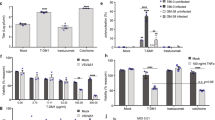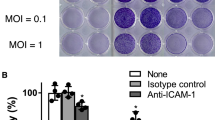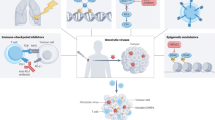Abstract
Using Chou–Talalay median effect analysis, we demonstrated in permanent and short-term cultures of colorectal cancer cells that the expression of measles virus fusogenic membrane glycoproteins (FMGs) in combination with chemotherapy often causes over most of the cytotoxic dose range synergistic cell killing. In this combined treatment, we observed strongly enhanced annexin V binding and caspase-3/7 activity when compared to single-agent treatment. Furthermore, we showed increased expression of heat-shock protein (Hsp)70 and Hsp90α, but not of Hsp60. In a subcutaneous HT-29 colorectal xenograft model, we demonstrated that the administration of a replication-defective adenoviral or herpes simplex virus (HSV) amplicon vector (Ad.H/F or HSV.H/F) encoding tumor-restricted FMG in combination with FOLFOX significantly enhanced treatment outcome when compared to treatment with each compound individually. To increase the fraction of tumor cells expressing the FMG, we trans-complemented the Ad.H/F and HSV.H/F vector with the respective oncolytic replication-restricted adenovirus Ad.COXΔMK or HSV-1 G47Δ vector. At the end of the observation period (day 100), eight out of 10 animals that received G47Δ, HSV.H/F and FOLFOX were alive and tumor free. Administration of the analogous adenovirus-based regimen resulted in four out of 10 long-term survivors. We demonstrated that the expression of FMG in combination with chemotherapy can significantly enhance treatment outcome, which is further enhanced by combination with trans-complementing oncolytic vectors.
This is a preview of subscription content, access via your institution
Access options
Subscribe to this journal
Receive 12 print issues and online access
$259.00 per year
only $21.58 per issue
Buy this article
- Purchase on Springer Link
- Instant access to full article PDF
Prices may be subject to local taxes which are calculated during checkout





Similar content being viewed by others
References
Jemal A, Thomas A, Murray T, Thun M . Cancer statistics, 2002. CA Cancer J Clin 2002; 52: 23–47.
NIH consensus conference. Adjuvant therapy for patients with colon and rectal cancer. JAMA 1990; 264: 1444–1450.
Heidelberger C, Chaudhuri NK, Danneberg P, Mooren D, Griesbach L, Duschinsky R et al. Fluorinated pyrimidines, a new class of tumour-inhibitory compounds. Nature 1957; 179: 663–666.
Wein A, Riedel C, Bruckl W, Kastl S, Reingruber B, Hohenberger W et al. Weekly 24-h infusion of high-dose 5-fluorouracil (5-FU) with folinic acid (FA) in adjuvant therapy of colon cancer. Z Gastroenterol 2001; 39: 153–156.
Waxman S, Bruckner H . The enhancement of 5-fluorouracil anti-metabolic activity by leucovorin, menadione and alpha-tocopherol. Eur J Cancer Clin Oncol 1982; 18: 685–692.
Abigerges D, Chabot GG, Armand JP, Herait P, Gouyette A, Gandia D . Phase I and pharmacologic studies of the camptothecin analog irinotecan administered every 3 weeks in cancer patients. J Clin Oncol 1995; 13: 210–221.
Goldberg RM, Sargent DJ, Morton RF, Fuchs CS, Ramanathan RK, Williamson SK et al. A randomized controlled trial of fluorouracil plus leucovorin, irinotecan, and oxaliplatin combinations in patients with previously untreated metastatic colorectal cancer. J Clin Oncol 2004; 22: 23–30.
Dorig RE, Marcil A, Chopra A, Richardson CD . The human CD46 molecule is a receptor for measles virus (Edmonston strain). Cell 1993; 75: 295–305.
Erlenhoefer C, Wurzer WJ, Loffler S, Schneider-Schaulies S, ter Meulen V, Schneider-Schaulies J et al. CD150 (SLAM) is a receptor for measles virus but is not involved in viral contact-mediated proliferation inhibition. J Virol 2001; 75: 4499–4505.
Wild TF, Fayolle J, Beauverger P, Buckland R . Measles virus fusion: role of the cysteine-rich region of the fusion glycoprotein. J Virol 1994; 68: 7546–7548.
Caballero M, Carabana J, Ortego J, Fernandez-Munoz R, Celma ML . Measles virus fusion protein is palmitoylated on transmembrane–intracytoplasmic cysteine residues which participate in cell fusion. J Virol 1998; 72: 8198–8204.
Galanis E, Bateman A, Johnson K, Diaz RM, James CD, Vile R et al. Use of viral fusogenic membrane glycoproteins as novel therapeutic transgenes in gliomas. Hum Gene Ther 2001; 12: 811–821.
Li H, Haviv YS, Derdeyn CA, Lam J, Coolidge C, Hunter E et al. Human immunodeficiency virus type 1-mediated syncytium formation is compatible with adenovirus replication and facilitates efficient dispersion of viral gene products and de novo-synthesized virus particles. Hum Gene Ther 2001; 12: 2155–2165.
Ahmed A, Jevremovic D, Suzuki K, Kottke T, Thompson J, Emery S et al. Intratumoral expression of a fusogenic membrane glycoprotein enhances the efficacy of replicating adenovirus therapy. Gene Therapy 2003; 10: 1663–1671.
Nakamura T, Peng KW, Vongpunsawad S, Harvey M, Mizuguchi H, Hayakawa T et al. Antibody-targeted cell fusion. Nat Biotechnol 2004; 22: 331–336.
Bateman A, Bullough F, Murphy S, Emiliusen L, Lavillette D, Cosset FL et al. Fusogenic membrane glycoproteins as a novel class of genes for the local and immune-mediated control of tumor growth. Cancer Res 2000; 60: 1492–1497.
Dion LD, Goldsmith KT, Strong TV, Bilbao G, Curiel DT, Garver RIJ . E1A RNA transcripts amplify adenovirus-mediated tumor reduction. Gene Therapy 1996; 3: 1021–1025.
Alemany R, Lai S, Lou YC, Jan HY, Fang X, Zhang WW . Complementary adenoviral vectors for oncolysis. Cancer Gene Ther 1999; 6: 21–25.
Wildner O, Morris JC, Vahanian NN, Ford HJ, Ramsey WJ, Blaese RM . Adenoviral vectors capable of replication improve the efficacy of HSVtk/GCV suicide gene therapy of cancer. Gene Therapy 1999; 6: 57–62.
Wolkersdorfer GW, Morris JC, Ehninger G, Ramsey WJ . Trans-complementing adenoviral vectors for oncolytic therapy of malignant melanoma. J Gene Med 2004; 6: 652–662.
Hoffmann D, Wildner O . Restriction of adenoviral replication to the transcriptional intersection of two different promoters for colorectal and pancreatic cancer treatment. Mol Cancer Ther 2006; 5: 1–8.
Todo T, Martuza RL, Rabkin SD, Johnson PA . Oncolytic herpes simplex virus vector with enhanced MHC class I presentation and tumor cell killing. Proc Natl Acad Sci USA 2001; 98: 6396–6401.
Khuri FR, Nemunaitis J, Ganly I, Arseneau J, Tannock IF, Romel L et al. A controlled trial of intratumoral ONYX-015, a selectively-replicating adenovirus, in combination with cisplatin and 5-fluorouracil in patients with recurrent head and neck cancer. Nat Med 2000; 6: 879–885.
Aghi M, Rabkin S, Martuza RL . Effect of chemotherapy-induced DNA repair on oncolytic herpes simplex viral replication. J Natl Cancer Inst 2006; 98: 38–50.
Nakano K, Todo T, Zhao G, Yamaguchi K, Kuroki S, Cohen JB et al. Enhanced efficacy of conditionally replicating herpes simplex virus (G207) combined with 5-fluorouracil and surgical resection in peritoneal cancer dissemination models. J Gene Med 2005; 7: 638–648.
Chou J . Quantitation of synergism and antagonsim of two or more drugs by computerized analysis. In: Chou TC, Rideout DC (eds). Synergism and Antagonism in Chemotherapy. Academic Press: New York, 1991, pp 223–244.
Mittereder N, March KL, Trapnell BC . Evaluation of the concentration and bioactivity of adenovirus vectors for gene therapy. J Virol 1996; 70: 7498–7509.
CalcuSyn. Windows Software for Dose Effect Analysis. Windows. Cambridge, England: Biosoft, 1996.
Horn GP, Vongpunsawad S, Kornmann E, Fritz B, Dittmer DP, Cattaneo R et al. Enhanced cytotoxicity without internuclear spread of adenovirus upon cell fusion by measles virus glycoproteins. J Virol 2005; 79: 1911–1917.
Chou TC, Talalay P . Quantitative analysis of dose–effect relationships: the combined effects of multiple drugs or enzyme inhibitors. Adv Enzyme Regul 1984; 22: 27–55.
Volk AL, Rivera AA, Kanerva A, Bauerschmitz G, Dmitriev I, Nettelbeck DM et al. Enhanced adenovirus infection of melanoma cells by fiber-modification: incorporation of RGD peptide or Ad5/3 chimerism. Cancer Biol Ther 2003; 2: 511–515.
Higuchi H, Bronk SF, Bateman A, Harrington K, Vile RG, Gores GJ . Viral fusogenic membrane glycoprotein expression causes syncytia formation with bioenergetic cell death: implications for gene therapy. Cancer Res 2000; 60: 6396–6402.
Xanthoudakis S, Roy S, Rasper D, Hennessey T, Aubin Y, Cassady R et al. Hsp60 accelerates the maturation of pro-caspase-3 by upstream activator proteases during apoptosis. EMBO J 1999; 18: 2049–2056.
Melcher A, Todryk S, Hardwick N, Ford M, Jacobson M, Vile RG . Tumor immunogenicity is determined by the mechanism of cell death via induction of heat shock protein expression. Nat Med 1998; 4: 581–587.
Ran R, Lu A, Zhang L, Tang Y, Zhu H, Xu H et al. Hsp70 promotes TNF-mediated apoptosis by binding IKK gamma and impairing NF-kappa B survival signaling. Genes Dev 2004; 18: 1466–1481.
Simon MC, Kitchener K, Kao HT, Hickey E, Weber L, Voellmy R et al. Selective induction of human heat shock gene transcription by the adenovirus E1A gene products, including the 12S E1A product. Mol Cell Biol 1987; 7: 2884–2890.
Ram Z, Culver KW, Oshiro EM, Viola JJ, DeVroom HL, Otto E et al. Therapy of malignant brain tumors by intratumoral implantation of retroviral vector-producing cells. Nat Med 1997; 3: 1354–1361.
Jain RK . Physiological barriers to delivery of monoclonal antibodies and other macromolecules in tumors. Cancer Res 1990; 50: 814s–819s.
Lee CT, Park KH, Yanagisawa K, Adachi Y, Ohm JE, Nadaf S et al. Combination therapy with conditionally replicating adenovirus and replication defective adenovirus. Cancer Res 2004; 64: 6660–6665.
Bett AJ, Prevec L, Graham FL . Packaging capacity and stability of human adenovirus type 5 vectors. J Virol 1993; 67: 5911–5921.
Zalmanzon ES, Mikhailova LN . The effect of pre-inhibition of DNA synthesis in continuous human amniotic cell culture (strain FL) on adenovirus type 5 reproduction. Acta Virol 1969; 13: 353–362.
Wildner O, Hoffmann D, Jogler C, Uberla K . Comparison of HSV-1 thymidine kinase-dependent and -independent inhibition of replication-competent adenoviral vectors by a panel of drugs. Cancer Gene Ther 2003; 10: 791–802.
Fu X, Tao L, Jin A, Vile R, Brenner MK, Zhang X . Expression of a fusogenic membrane glycoprotein by an oncolytic herpes simplex virus potentiates the viral antitumor effect. Mol Ther 2003; 7: 748–754.
Chen TR, Hay RJ, Macy ML . Intercellular karyotypic similarity in near-diploid cell lines of human tumor origins. Cancer Genet Cytogenet 1983; 10: 351–362.
Didier ES, Rogers LB, Orenstein JM, Baker MD, Vossbrinck CR, Van GT et al. Characterization of Encephalitozoon (Septata) intestinalis isolates cultured from nasal mucosa and bronchoalveolar lavage fluids of two AIDS patients. J Eukaryot Microbiol 1996; 43: 34–43.
Smith IL, Hardwicke MA, Sandri-Goldin RM . Evidence that the herpes simplex virus immediate early protein ICP27 acts post-transcriptionally during infection to regulate gene expression. Virology 1992; 186: 74–86.
Esimone CO, Grunwald T, Wildner O, Nchinda G, Tippler B, Proksch P et al. In vitro pharmacodynamic evaluation of antiviral medicinal plants using a vector-based assay technique. J Appl Microbiol 2005; 99: 1346–1355.
He TC, Zhou S, da Costa LT, Yu J, Kinzler KW, Vogelstein B . A simplified system for generating recombinant adenoviruses. Proc Natl Acad Sci USA 1998; 95: 2509–2514.
Inoue H, Tanabe T, Umesono K . Feedback control of cyclooxygenase-2 expression through PPARgamma. J Biol Chem 2000; 275: 28028–28032.
Uehara K, Matsubara S, Kadomatsu K, Tsutsui J, Muramatsu T . Genomic structure of human midkine (MK), a retinoic acid-responsive growth/differentiation factor. J Biochem (Tokyo) 1992; 111: 563–567.
Horikawa I, Cable PL, Afshari C, Barrett JC . Cloning and characterization of the promoter region of human telomerase reverse transcriptase gene. Cancer Res 1999; 59: 826–830.
Graham FL, Prevec L . Methods for construction of adenovirus vectors. Mol Biotechnol 1995; 3: 207–220.
Chou J, Kern ER, Whitley RJ, Roizman B . Mapping of herpes simplex virus-1 neurovirulence to gamma 134.5, a gene nonessential for growth in culture. Science 1990; 250: 1262–1266.
Jugovic P, Hill AM, Tomazin R, Ploegh H, Johnson DC . Inhibition of major histocompatibility complex class I antigen presentation in pig and primate cells by herpes simplex virus type 1 and 2 ICP47. J Virol 1998; 72: 5076–5084.
Krisky DM, Marconi PC, Oligino TJ, Rouse RJ, Fink DJ, Cohen JB et al. Development of herpes simplex virus replication-defective multigene vectors for combination gene therapy applications. Gene Therapy 1998; 5: 1517–1530.
Goldstein DJ, Weller SK . Herpes simplex virus type 1-induced ribonucleotide reductase activity is dispensable for virus growth and DNA synthesis: isolation and characterization of an ICP6 lacZ insertion mutant. J Virol 1988; 62: 196–205.
Saeki Y, Fraefel C, Ichikawa T, Breakefield XO, Chiocca EA . Improved helper virus-free packaging system for HSV amplicon vectors using an ICP27-deleted, oversized HSV-1 DNA in a bacterial artificial chromosome. Mol Ther 2001; 3: 591–601.
Richardson CD, Scheid A, Choppin PW . Specific inhibition of paramyxovirus and myxovirus replication by oligopeptides with amino acid sequences similar to those at the N-termini of the F1 or HA2 viral polypeptides. Virology 1980; 105: 205–222.
Hitt DC, Booth JL, Dandapani V, Pennington LR, Gimble JM, Metcalf J . A flow cytometric protocol for titering recombinant adenoviral vectors containing the green fluorescent protein. Mol Biotechnol 2000; 14: 197–203.
Chou TC . The median–effect principle and the combination index for quantitation of synergism and antagonism. In: Chou TC, Rideout DC (eds). Synergism and Antagonsim in Chemotherapy. Academic Press: New York, 1991, pp 61–102.
Acknowledgements
We thank Professor Klaus Überla for creating an inspiring environment and providing constant support. Furthermore, we are grateful to Professor Andrea Frilling (Klinik für Allgemeine und Transplantationschirurgie). Furthermore, we thank Dr Cathrin Walter ((Innere Klinik – Tumorforschung) Universitätsklinikum Essen, Germany) for critical review of this manuscript and Professor Matthias Dobbelstein and Dr German P Horn, Institute of Virology, Philipps-Universität Marburg, for helpful discussions and advice. This work was supported by grants from Deutsche Forschungsgemeinschaft and Wilhelm Sander-Stiftung to OW.
Author information
Authors and Affiliations
Corresponding author
Rights and permissions
About this article
Cite this article
Hoffmann, D., Bangen, JM., Bayer, W. et al. Synergy between expression of fusogenic membrane proteins, chemotherapy and facultative virotherapy in colorectal cancer. Gene Ther 13, 1534–1544 (2006). https://doi.org/10.1038/sj.gt.3302806
Received:
Revised:
Accepted:
Published:
Issue Date:
DOI: https://doi.org/10.1038/sj.gt.3302806
Keywords
This article is cited by
-
Oncolytic viruses against cancer, promising or delusion?
Medical Oncology (2023)
-
Use of cell fusion proteins to enhance adenoviral vector efficacy as an anti-cancer therapeutic
Cancer Gene Therapy (2021)
-
Synergy between hemagglutinin 2 (HA2) subunit of influenza fusogenic membrane glycoprotein and oncolytic Newcastle disease virus suppressed tumor growth and further enhanced by Immune checkpoint PD-1 blockade
Cancer Cell International (2020)
-
Concurrent chemotherapy inhibits herpes simplex virus-1 replication and oncolysis
Cancer Gene Therapy (2013)
-
Polyinosinic acid decreases sequestration and improves systemic therapy of measles virus
Cancer Gene Therapy (2012)



